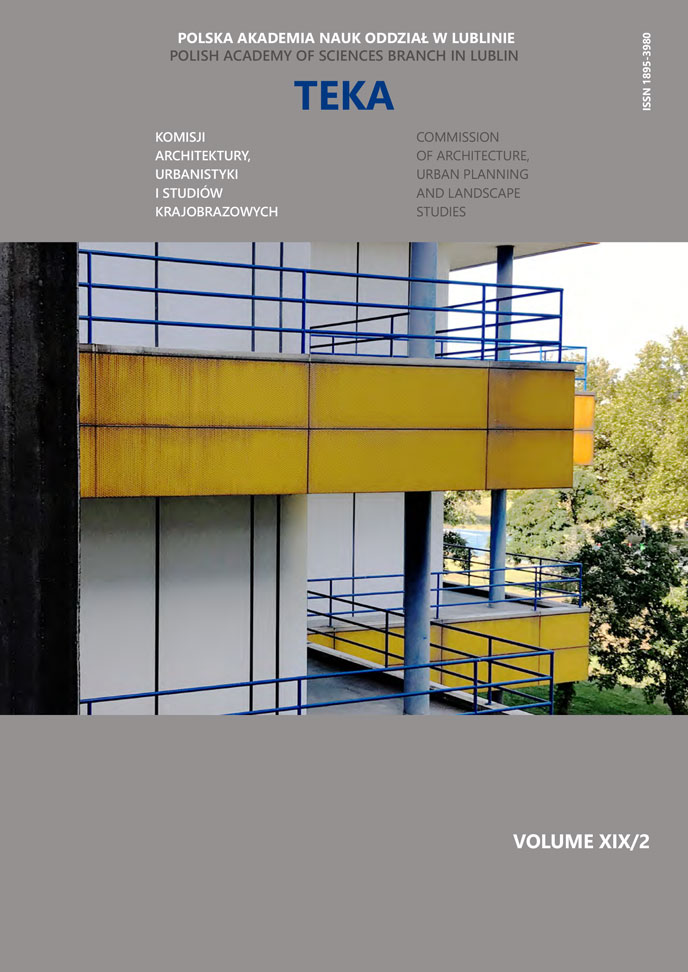Impact of sampling technique on the reliability of gravimetric moisture test results
Article Sidebar
Open full text
Issue Vol. 19 No. 2 (2023)
-
On the preservation of the image of the architectural and urban planning complex of Adam Mickiewicz Square in Lviv
Mykola Bevz7-25
-
Impact of sampling technique on the reliability of gravimetric moisture test results
Weronika Kendzierawska, Maciej Trochonowicz, Wojciech Chachaj26-34
-
Thermo-modernisation of 20th century hospital buildings – material and technical aspects
Natalia Przesmycka, Anna Życzyńska, Rafał Strojny35-45
-
From Monofunctional Commercial Districts into Multifunctional Urban Areas – Implementation of Sustainable Urban Practices
Barbara Miączyńska, Andrzej Borkowski46-57
-
The largest but little-known monastery of Lviv: architectural image of the former convention of the Shoeless Carmelites
Mykola Bevz, Yuri Dubyk58-74
-
Habitat – structure and form, design experience in teaching interior design.
Emilia Malec-Zięba75-88
-
Urban Design 1960−2020. Evolution of the curriculum. Case of Faculty of Architecture, Wroclaw University of Science and Technology
Agnieszka Szumilas89-95 -
Primary school buildings in the Lublin area designed by the architect Bohdan Kelles‑Krauze during the interbellum period
Ewa Miłkowska96-105
-
Design approach to challenging architectural facilities Perception of psychiatric treatment of adolescents in Poland and quality of hospital space from the perspective of potential patients
Agata Gawlak, Daria Smyl106-123
-
Concrete around us. Building and climate change
Marek Piróg124-129
-
Promoting Active Pedestrian Transport as an Urban Planning Challenge in Contemporary Cities
Elżbieta Przesmycka130-137
Archives
-
Vol. 20 No. 3
2024-12-27 7
-
Vol. 20 No. 2
2024-12-27 7
-
Vol. 20 No. 1
2024-12-27 8
-
Vol. 19 No. 2
2023-12-29 11
-
Vol. 19 No. 1
2023-12-19 13
-
Vol. 18 No. 4
2022-12-30 5
-
Vol. 18 No. 3
2022-12-27 5
-
Vol. 18 No. 2
2022-12-27 5
-
Vol. 18 No. 1
2022-12-27 4
-
Vol. 17 No. 4
2021-12-30 11
-
Vol. 17 No. 3
2021-12-30 9
-
Vol. 17 No. 2
2021-12-30 8
-
Vol. 17 No. 1
2021-12-30 8
-
Vol. 15 No. 4
2019-12-30 6
-
Vol. 15 No. 3
2019-10-31 9
-
Vol. 15 No. 2
2019-06-28 12
-
Vol. 15 No. 1
2019-03-29 13
Main Article Content
DOI
Authors
Abstract
Humidity is one of the basic physical characteristics of a material. Laboratory tests to determine the percentage water content of a material are relatively simple and do not require sophisticated testing equipment. The problem, however, is the reliability of partition humidity tests. During this type of testing, it is necessary to take samples from the building and transport them to the laboratory. During both of these activities, there is a loss in the mass of water contained in the sample. Changes in the humidity of the samples, associated with the need to transport them, can be minimised by using airtight containers and lowering the temperature. A much more difficult issue to address is the elimination of losses in the mass of water contained in the samples during sampling. Laboratory moisture test manuals recommend sampling by forging methods or by so-called tube drifters. Such sampling methods are intended to exclude water mass losses. In many cases, it is necessary to take a sample from quite a considerable depth or the tests concern objects of high historical value. This precludes the sampling methods recommended by the instructions. For this reason, the most commonly used sampling method, in existing facilities, is to drill a borehole and testing the borehole. During the drilling process, overheating of the borehole occurs and evaporation of water. In scientific literature and technical studies of all kinds, it is quite often suggested to take this phenomenon into account. Unfortunately, there is no information on the value of the corrections to be made. The aim of this study is to demonstrate the difference in bulk humidity measured by the laboratory method of the same samples with different sampling techniques. In addition, correction values have been determined for specific humidity ranges.
Keywords:
References
Dylla A., Fizyka cieplna budowli w praktyce: obliczenia cieplno-wilgotnościowe, Wydawnictwo naukowe PWN, Warszawa 2015.
Hoła J., Degradacja budynków zabytkowych wskutek nadmiernego zawilgocenia – wybrane problemy, Budownictwo i Architektura 17(1) (2018) 133−148. DOI: https://doi.org/10.24358/Bud-Arch_18_171_17
Kamiński K., Wilgotność higroskopijna podstawą diagnostyki stanu zawilgocenia przegrody budowlanej, Materiały Budowlane 3`2014, 20−21.
Kubik J., Przepływ wilgoci w materiałach budowlanych. Politechnika Opolska, Opole 2000.
Matkowski Z., Problemy związane z metodyką pomiarów wilgotności ścian murowanych w obiektach zabytkowych.
PN-EN ISO 12570. Cieplno-wilgotnościowe właściwości materiałów i wyrobów budowlanych. Określanie wilgotności przez suszenie w podwyższonej temperaturze.
Praca zbiorowa, red. Klemm P., Budownictwo ogólne. Tom 1. Materiały i wyroby budowlane, Warszawa, Arkady, 2009.
Trochonowicz M., Szostak B., Lisiecki D., Analiza porównawcza badań wilgotnościowych metodą chemiczną w stosunku do badań grawimetrycznych wybranych materiałów budowlanych, Budownictwo i Architektura 15(4) (2016) 163−171. DOI: https://doi.org/10.24358/Bud-Arch_16_154_16
Trochonowicz M., Wilgoć w obiektach budowlanych. Problematyka badań wilgotnościowych, Budownictwo i Architektura 7/2010. DOI: https://doi.org/10.35784/bud-arch.2274
Wójcik R., Pomiary wilgotności przegród budowlanych, Materiały Budowlane 8/2002.
Wyrwał J., Świrska J., Problemy zawilgocenia przegród budowlanych, Komitet Inżynierii Lądowej i Wodnej PAN, 1998.
PN-EN 12664 „Właściwości cieplne materiałów i wyrobów budowlanych. Określanie oporu cieplnego metodami osłoniętej płyty grzejnej i czujnika strumienia cieplnego”.
Article Details
Abstract views: 208
License

This work is licensed under a Creative Commons Attribution-ShareAlike 4.0 International License.


